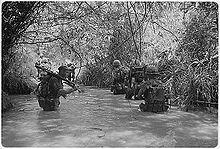Jungle war

The expression jungle war in the military refers to any kind of combat action in the jungle , i.e. in dense, mostly tropical rainforest in the hot and humid climatic zone of the tropics . This requires special equipment and clothing. The fighting style is similar to that in the forest fight with a deep staggering and strong reserves as well as only limited support from armored personnel carriers of the armored infantrymen and battle tanks of the armored forces. The own artillery and the air force can only support the own infantry to a limited extent due to the difficult conditions and insufficient localization.
General

The jungle war poses problems for modern armies , since it requires considerable changes in the procedure compared to other combat situations. Due to the special terrain, the use of vehicles, from jeeps to trucks to tanks, is not possible. Support from artillery or close air support is often only possible to a limited extent. Continuous supply and the relief of troops in the jungle war also make high logistical demands. The constant heat, the high humidity and the omnipresent mud not only damage the health and morale of the soldiers , but also attack technical equipment. Weapons, radios, tools, even clothing and shoes require permanent care in order not to fail. Many common weapons cannot be used because of the dense tree population: For example, there is not enough space to throw hand grenades far enough. The same applies to rifle grenades and mortar ammunition . Due to the limited visibility, artillery can only partially support the fight of its own infantry, artillery shells explode as soon as you touch the tree tops.
A further burden often turns out to be not only numerous partly fatal diseases such as B. Malaria or Legionnaires' disease , as well as poisonous and dangerous animals such as snakes , but also the often long isolation of the troops from any civilization . Over time, the soldiers felt that they were only fighting "for the next piece of jungle".
history
The first Europeans to experience the jungle fight as described above were the Spanish and Portuguese Conquistadores , who conquered South America between 1500 and 1600. While searching for El Dorado , thousands of them died in the jungle.
The Battle of Guadalcanal in World War II also led to jungle fighting , especially during the reconquest of New Guinea and Burma , where the British and their colonial troops fought against the Japanese army .
Vietnam
During the Vietnam War , the US armed forces tried to compensate for these problems with the massive use of Bell UH-1 transport helicopters .
In the jungle, clearings were cleared where camps were set up. The helicopters flew the infantry into the areas of operation, offered fire support with their M60 machine guns operated by Doorgunners , instructed artillery and Air Force , flew in supplies and expelled the wounded and prisoners. After the fighting was over, they picked up the surviving GIs .
This strategy failed. The US soldiers were stuck in the camps and barracks, while the FNL was able to operate unhindered. If the so-called cavalry moved out, the helicopters could be heard and seen early on, and the guerrillas could move around at will. If they stood to fight, they could fire on the low-flying helicopters long before they dropped the troops.
Due to the lack of success of its helicopter squadrons, the US changed its strategy. Now they tried to defeat the North Vietnamese from the air with massive napalm bombings , but also with new types of aircraft such as gunships .
This strategy also failed. Since the pilots could not see the enemy in the jungle, they were dependent on target assignments by the infantry or by observers from the air. The patrols roamed the jungle until they met the enemy . Then they passed the enemy coordinates on to the control centers, which instructed the air force. By the time the bombers arrived, the GIs must have withdrawn to avoid falling into friendly fire . The Vietnamese were also able to use this time to change their positions. As a result, most of the attacks failed. During this so-called Operation Rolling Thunder , the Americans used around 15 million tons of explosives; twice as much as during the entire Second World War .
Another popular US strategy was the use of herbicides such as Agent Orange to defoliate the jungle, deprive the guerrillas of basic food and deprive the guerrillas of retreat.
today
The French Foreign Legion is considered to be particularly qualified for the jungle fight . In Rochambeau , French Guiana , the Legion operates a training center in which not only legionnaires, but troops from all over the world are trained. The jungle badge that every "newbie" receives at the end of the basic course is hard-earned and highly coveted.
The Legion has learned from its experience of the Indochina War . It no longer relies on large troop marches and heavy weapons like the USA in Vietnam, but on fighting at group level. Small units with light weapons that can act independently of each other and of higher-ranking bodies. Above all, the legionaries should be independent of supplies for as long as possible. This is why the legionaries learn to feed themselves completely from the jungle and to use as many different weapons as possible. So they can use prey weapons and are not dependent on ammunition supplies.
The British Special Air Service trains its soldiers in the jungles of Belize . Other special units also take part in these courses.


